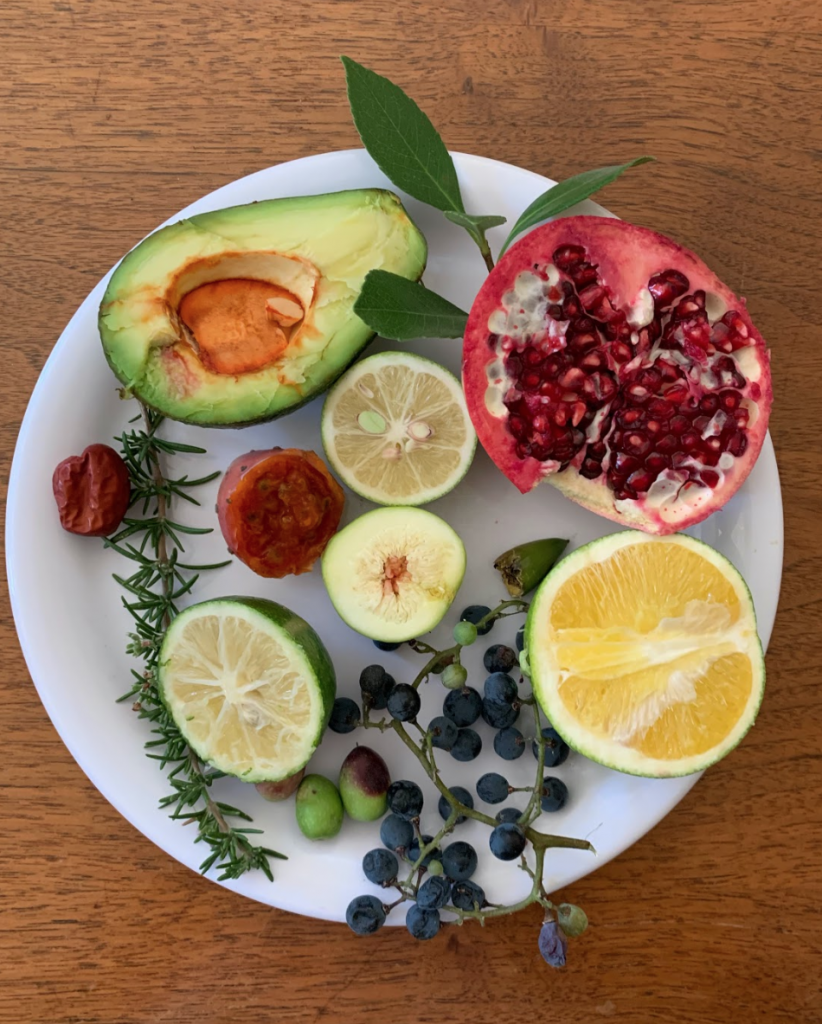Julia Cox ’23
Staff Writer
One of the most fickle aspects of our campus are its fruit trees— how can you tell when they’re ripe? Where are they? What’s in season? Following a semester of these questions, I have decided to end this fruit frustration once and for all. Here is a comprehensive guide to the fruit of Scripps, where you can find them, and what you can use them for. Welcome to your go-to place to learn about fruit and other edible plants at Scripps.
Season Ends Soon
– Grapes (May-October): A well-known attraction of Schow Hall, the grapes can both be found outside and inside the entrance, though I’d recommend the grapes inside. They’re tiny, sour, and have huge seeds, but are worth a try!
– White Sapotes (April-October): White sapotes look like green oranges and may be found in Browning near the Rose Garden.
– California Live Oak (August-October): The California live oak bears edible acorns that are a favorite of our campus squirrels. Though they can be bitter, once soaked in water they have a sweet and nutty flavor similar to a chestnut. There’s a large California live oak outside of Dorsey Hall on Jaqua Quadrangle in addition to in front of Bowling Green lawn.
In Season Now
– Bay Laurel (all year): Typically used as a seasoning or garnish (often found in your Chipotle rice), bay leaves are thick, green leaves about two inches long and are located between Bowling Green and Jaqua.
– Avocado (all year): If making fresh avocado toast in your dorm sounds too good to be true, it probably is. I got my underripe avocado from a tree outside Huntley Bookstore though they’re said to be near Revelle House as well.
– Pomegranate (August-December): Especially when considering the ripeness and taste of other campus fruits, these pomegranates were great! For the biggest and ripest ones, I would recommend taking a trip to the oasis (located between and behind Toll Hall and Clark Hall). There’s a tree on the Toll side that has good, though slightly bitter, fruit.
– Fig (all year): As long as you pick figs when they’re soft, they’re delicious! I would recommend pairing figs with goat cheese on a cracker or making jam. They can be found in Schow.
– Chinese Date/Jujube (September-December): Shriveled and red, these can be found in a medium-sized tree outside on the north side of Browning Hall. Chinese dates help to strengthen the immune system and can even help with insomnia.
– Lime (August-December): Limes can be found on the small trees right outside the door of Gabrielle Jungels-Winkler (GJW) Hall. Though I didn’t muster the courage to endure a sample of the tart fruit, they have a pleasant smell and appear to be ripe.
– Olive (September-November): Though you’ll probably have to climb a tree to get a ripe olive, they can be found in the Margaret Fowler Garden and around the Humanities Building.
– Rosemary (all year): Found just inside the Clark bike storage area, rosemary is great for improving digestion and can be used while cooking with various meats or even as a sandwich spread when mixed with goat cheese.
– Prickly Pear/Nopales (May-November): These are red, spiky bulbs attached to cacti that may be found in the courtyard of Browning. Fair warning: it’s easy to get locked into this courtyard, and these nopales are extremely prickly. Definitely protect your hands when grabbing them, and have a friend outside the door to let you back in.
Soon-to-be in Season
– Meyer Lemon (November-May): I couldn’t find a ripe one, but they’re located inside GJW. Meyer lemons are slightly sweeter than other types and have a hint of orange flavor, perfect for lemonades or in lemon bars.
– Kumquats (November-March): Unfortunately none are ripe right now, but I had one in early September that was a perfect balance of sweet and sour. You can find kumquats in Vita Nova near the dance studio.
– Oro Blanco Grapefruit (December-April): Located outside Balch on Columbia, oro blanco grapefruits are yellow, sweet and seedless. Grapefruits are great for breakfast and can even be juiced!
– Seville Orange (December-February): Seville oranges are more bitter than other types of oranges, are typically used for marmalade or jam, and may be found outside of Dorsey’s balconies.
Off-Season
– Navel Orange (January-April): These oranges are sweet compared to their bitter Seville relatives. They can be found near the entrance to Dorsey, and – fun fact – reproduce asexually.
– Valencia Orange (March-June): This fruit is the most popular orange variety and is typically used for juice. They line the path that leads to Toll.
– Eureka Lemon (March-June): More sour than Meyer lemons, Eureka lemons are outside Revelle house. They’re the most popular type of lemon and are great for lemonade.
– Strawberry Guava (April-May): Strawberry guavas are small, red fruits that grow on trees between Dorsey and GJW. They are sweet and look like mini pomegranates.
– Loquat (April-May): Loquats are very similar to kumquats aside from their lighter orange color. Located outside Toll, loquats are tangy and juicy.
For a more detailed view of fruits and their locations, visit the Scripps College Edible Plants map in the Motley.
10/30, Volume XXIX, Issue 3



